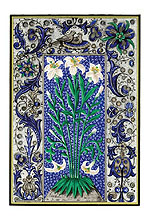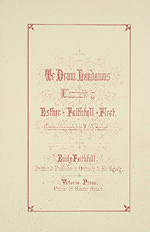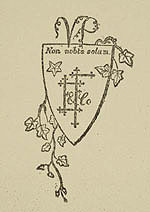Emily Faithfull
British, 1835-1895
Little is known of Faithfull's personal life, but her record
of philanthropy and activism for women's welfare is exemplary.
The lack of opportunities for women to learn any trade or profession
particularly concerned her, and led her to found the Society for
Promoting the Employment of Women in 1859 and then her own Victoria
Press in
1860, where she employed only women compositors. She also hired men,
both to teach the women how to set type and to do some of the presswork
and lifting of heavy chases. This "mixed shop," however,
met with enormous hostility from the printer's union, supposedly
on moral grounds. Presses were sabotaged and ink poured on the women's
chairs (Faithfull had introduced the novelty of providing the typesetters
with tall, three-legged stools to alleviate some of the fatigue of
standing at the case during their twelve-to fourteen-hour workday).
Nevertheless, the Victoria Press continued in operation for twenty
years, producing a solid body of work, including thirty-five volumes
of the Victoria Magazine, which advocated the right of women
to gainful employment. Faithfull also won the support of the sovereign,
and
was appointed Printer and Publisher in Ordinary to Her Majesty in
1862.
One of the most beautiful books published by Emily Faithfull is
the Te Deum Laudamus. It is typical
of the Victorian
era in its rich colors and intricate decorative patterns. A new technique
known as chromolithography, patented at mid-century, enabled printers
to reproduce colors (using a separate stone for each color) more
vividly than ever before. Also notable is the way in which text and
image are
interwoven, sometimes to the detriment of readability. The iconography
of this image was explained by Faithfull herself: "The blue
and white of this Plate are the well-known colours of the Virgin;
the lily
is the emblem of the Incarnation, and the doves refer to the offering
in the temple at the time of the Purification (Luke ii.24)."
 |
 |
Te Deum Laudamus, illuminated by Esther Faithfull Fleet;
chromolithographed by M. & N. Hanhart
London: Emily Faithfull, Printer & Publisher in Ordinary to Her
Majesty; Victoria Press, 1868.
Rare Books Division, Robert Metzdorf Collection
of Victorian Bookbindings

Emily Faithfull’s printer’s mark, which combined
her initials “EF & Co” within a shield crowned
with “VP” (for her Victoria Press).
Poems: An Offering to Lancashire. Printed and Published for
the Art Exhibition for the Relief of Distress in the Cotton Districts.
London: E. Faithfull, Victoria Press, 1863.
Rare Books Division
Other works in the exhibition:
- Three Visits to America.
New York: Fowler & Wells, 1884.
The Princeton Collections of Western
Americana, Gift of Philip Ashton Rollins, Class of 1889
In 1872, 1877, and again in 1882, Faithfull visited and lectured
on women's rights in the United States, which she described
in her book Three Visits to America, published in 1884.